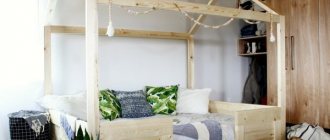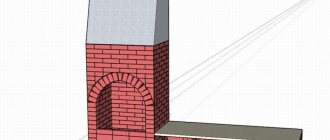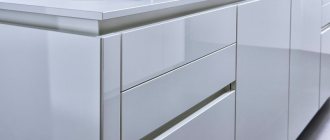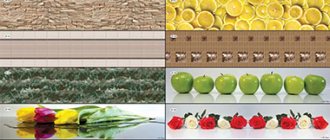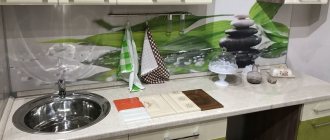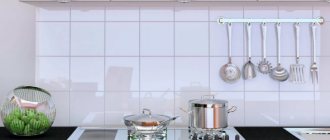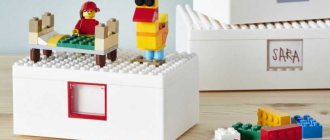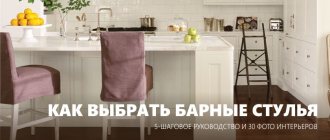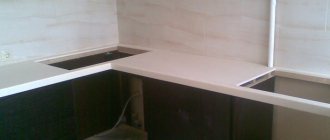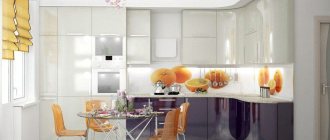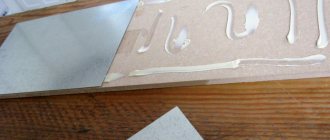In furniture production, HPL and CPL plastic stickers are used as cladding for chipboard/MDF/Tamburat panels. The plastic sticker allows you to significantly expand the range of decors of slab materials and furniture parts made from them. Plastic stickers are actively used for the production of furniture facades with non-standard decors, as well as in the production of parts that require increased resistance to physical and mechanical loads, high temperatures, and abrasion.
In the production of furniture parts, we use HPL/CPL plastics produced by Egger and Sloplast. The standard size of a plastic sheet is 3050 (2800) x 1300 mm. The thickness of the plastics is 0.6-0.8mm.
| Service type | Unit measurements | Price |
| Gluing two plates | sq.m. | 712 RUR |
| BSP sticker (price per side) | sq.m. | 916 RUR |
Here you can familiarize yourself with the range of plastics offered, as well as their physical and mechanical properties.
Gluing and gluing of plastic is carried out in a hot 2-port hydraulic press
Plastic for the kitchen
Gradually, new, interesting materials come into our lives.
Once upon a time tiles, concrete, and decorative stone were used; today many people prefer MDF, chipboard and plastics. The latter began to be actively used in construction, in everyday life, and in the creation of furniture for bathrooms, living rooms, bedrooms, hallways, kitchens, which is quite justified. Decorative plastic for furniture meets the highest quality requirements. The decorative layer of this paper-laminated material can have either a glossy or matte surface, or a surface combined in the form of a pattern, for example, flowers, and can be made in various colors: from popular monochrome, “wood” and “stone” to fancy decors like silver or gold with a pearlescent or metallic sheen. Modern decorative plastic for furniture produced by LEMARK opens up wide opportunities for the implementation of design ideas. Today you can buy laminated plastic of different textures, having either ornate patterns in the form of flowers, ornaments, or with a perfectly smooth or corrugated surface that imitates natural wood of various species, granite and slate, or a smooth, high-gloss surface.
Among the variety of products made from DBSP, a special place is occupied by kitchen facades and countertops with plastic HPL coating. Thanks to the hygiene of DBSP, ease of care, and high performance characteristics, such furniture will last for many years. It is no coincidence that facades, countertops, shelves and wall aprons with decorative laminated paper plastic HPL can be found in kitchens in the middle, high and even premium price segments. It's all about its thickness and protective layer. The greater the thickness of the facing plastic, the higher its impact strength and the better quality of products obtained from it. However, the thicker and better the protective layer, the more expensive it is. That is why, for example, in kitchens in the low price segment, as a rule, matte CPL plastics with a thickness of 0.4 or 0.5 mm and without a protective layer are used on countertops. In kitchens of the middle price segment, the thickness of the plastic is already 0.6-0.7 mm; as a rule, there is a special protective layer, a glossy finish (only HPL DBSP can have such a finish), and various embossings that imitate natural materials. In kitchens of the high price and premium segments, only high-pressure decorative plastic (HPL DBSP) or, as it is often called, HPL laminate, with a thickness of 1 mm to 25 mm with a special protective layer, is used. At the same time, the dark brown strip visible on the cut of laminated plastic is its business card, by which one can determine the thickness and can easily be distinguished from cheaper analogues, such as various NON-LAMIED plastics such as: PVC films, single-layer melamine films and films with a finish. effect or laminated chipboard (chipboard). Thanks to the presence of a wide variety of decors and embossing in the collection of laminated plastics LEMARK, furniture made with HPL Lemark will decorate kitchens of various styles, not only in high-tech style, but also in Provence, modern and even classic styles. Today you can buy plastic for furniture facades and tabletops, distinguished by both bright, saturated colors, which further emphasizes the futuristic design, and with patterns and embossing that completely imitate shabby, aged over the years, but so warm wood.
Description of PVC panels
The abbreviation PVC stands for polyvinyl chloride. In fact, it is ordinary plastic, which was given the desired shape during production. PVC panels have been used as a finishing material for many years. This became possible thanks to the undoubted advantages that the panels have. Among them are:
- Durability, service life up to 10 years.
- Easy to care for.
- Environmentally friendly.
- Moisture resistance.
- Fire safety.
- Resistance to low and high temperatures.
- Good sound insulation.
- Can be attached to different surfaces and the like.
Many customers also like the fact that the stores offer a huge number of colors, with a variety of designs printed on the panels. If you want to make an inexpensive but beautiful renovation, then this material will be a good choice. The main thing is to choose a good manufacturer and pay attention to possible defects in the product. The panels are easy to buy and, importantly, easy to install.
There are two main ways in which you can attach plastic panels to the wall:
- Attaching panels to the frame. This can be done mechanically, that is, using screws, nails or staples. The sheathing itself can be metal, wood or plastic. The panels can also be glued to the frame, which in this case will act as a wall leveler. This method of fastening - to the sheathing - has its pros and cons. Those who don't want to spend too much time installing the frame and lose precious square centimeters in the bathroom can choose a different route.
- Gluing to the wall. This method has virtually no effect on the area of the room being repaired. But it has its limitations. The walls must be smooth, dry, and the adhesive composition must be well selected, then the repair work will give the right result.
You must understand that not every glue is suitable for attaching this finishing material. Some compounds may damage the plastic or do not withstand moisture well. Therefore, it is better to know in advance than to glue PVC panels to the wall.
Solupren X2
| Contact adhesive Aspruzzo X2 | |
| Brand | Solupren (Italy) |
| vendor code | Solupren X2 |
| Packaging, kg | 16 |
| Purpose |
|
| The basis |
| Polychloroprene |
| Properties |
|
The plastic was cut with a small allowance for further milling
The edge of the facade will be the same plastic; it must be cut into strips 19 mm wide, this is the standard size of edge materials.
The next step is to apply glue to the surfaces to be glued, to the base of the facade and the plastic, since in our case the plastic has a matte finish and a fairly decent thickness of 1 mm and deep embossing (relief or bump in the language of 3D graphics visualizers), the glue can be evenly applied using a roller with fine pile or apply by spraying.
Let the glue dry slightly, readiness can be checked by lightly touching it with the back of your hand (by the way, I don’t know what the back of the hand is called and I’m unlikely to ever find out), no particles of glue should stick to the skin. Or, as recommended, 10-15 minutes, without blowing, 5 minutes with blowing.
We carefully apply the plastic to the base material; it is advisable to carry out these operations together, since if the application is incorrect or inaccurate, further adjustments to the bonded surfaces will be impossible.
Deciding on the material
It turns out that there are different types of polymer, so sometimes all our attempts to glue a polymer product together do not lead to the desired result.
It is impossible to determine the type of polymer by eye or touch, so let’s inspect our product for markings that resemble a Mobius Loop with different meanings. Types of polymer can be seen in the photo. Depending on the marking, you can choose glue today for any product. But even in the case when an advertisement invites you to purchase a universal miracle glue, you should not count on effective gluing; perhaps this is just a PR trick.
Having “recognized” the polymer material more closely, you need to select your own solvent for its type:
- Brand PA66 is glued using a solvent containing formic acid.
- The PMMA grade requires dichloroethane.
- ABS - acetone glue is suitable.
Storage and conditioning
HPL plastic sheets must be stored in a horizontal position; the sheets are folded in pairs, one on one, with the decorative surface facing each other (placed on a flat, durable surface - racks). It is not recommended to place sheets vertically.
Storage at an angle of 60° to the surface using supports is allowed. The material must be stored in a covered, dry room (room temperature: 10-30°C; room humidity: 50-65%). Before starting the production of furniture facades, it is necessary to keep all blanks in the room in which the work will take place.
HPL plastic for kitchen facades and the base on which it will be glued must be at the same temperature. A damp sheet of material may crack and delaminate, and a damp sheet may swell if not enough glue is used. Therefore, it is very important to follow the recommendations for storing the material.
In exceptional cases, HPL plastic sheets can be dried quickly: the plastic, separated by boards, is placed in a heated room (for about 2 hours at room temperature 50°C or 3 hours at 40°C). You can also place two sheets of HPL plastic facing each other and place them in a hot press for a short period of time (10 minutes at 70°C). This type of drying must be done several hours before you start gluing it.
What to look for when choosing glue
In order for plastic panels to last a long time and have a presentable appearance, you should take the choice of adhesive seriously.
It is worth noting that in construction stores you can find adhesives that are intended specifically for installing PVC boards. However, a situation may arise when there is no such product or the owner of the premises has some preferences. Usually, those who are planning to do repairs themselves are puzzled of what kind of glue to use The choice of means for fastening is, of course, important, but we must not forget about other conditions.
The adhesive composition for PVC panels must have the following properties:
- After drying, it should be transparent so as not to spoil the appearance of the finish.
- The composition used must be well resistant to moisture, temperature changes, cold, and the like.
- It is important that the glue sets quickly.
- The quality of gluing should be as high as possible.
- It is also worth considering the durability of the fastening.
- The glue used must be safe for health, so you should avoid toxic compounds that have a strong odor.
It would be useful to have antibacterial additives in the glue . A correctly selected composition will ensure that the finishing material is well attached to the wall and the panels will decorate the room for many years, despite the aggressive effects of water and temperature changes.
cutting
- Cutting tools are recommended to be used with carbide tips
- During the cutting process, the HPL plastic sheet should be placed on a clean and flat surface with the decorative side down
- Saw direction: from the side of the decorative layer (to prevent chipping)
- Cutting speed: 25-40 m/min
- The internal corners of the grooves must be rounded (to avoid chips and cracks)
- Diameter of steel saw for straight cutting: 25 – 45 cm
- Diameter of steel saw for curve cutting: 12 – 16 cm
- When cutting, it is most important to consider three factors: accurate guide, sufficient pressure on the HPL sheet at the cut site (use pressing tools), correct blade projection
- It is allowed to cut two sheets at the same time if maintaining the exact dimensions is not critical
- It is recommended to use blades thicker than 2mm (otherwise they may leave jagged edges on the material)
- For cutting complex formats, use a band saw and fine-tooth blades (such as those used for cutting light metals)
We work with plastic, which is widely used in furniture production
Plastic has become such a part of our lives that we sometimes wonder how we ever managed without it. It is used as a facing material. It is also indispensable in furniture production, since it is highly resistant to fats, food products, and chemicals.
If you stick plastic onto MDF and chipboard, you can solve many problems of housewives who cook in the kitchens. This also allows you to significantly transform future furniture.
High-quality gluing is provided by HolzMarkt specialists, who use modern materials and advanced technologies when performing this procedure.
Drilling
- When drilling holes, place the HPL sheet on a solid base of chipboard or wood
- Recommended drills: sharp angle twist drills with wide drilling gap
- Recommended drill sharpening angle: 60° and 80°
- Drills for making holes up to 15 mm in diameter: screw
- Drills for making holes with a diameter of 15-40 mm: expanding
- To produce holes with a diameter of more than 40 mm, adjustable circular blades with a guide are used. The hole is drilled on both sides
- When drilling holes, the surface of the HPL plastic should not heat up
- A sheet of HPL plastic can slightly change its dimensions when exposed to temperature, so the holes for fasteners must be larger in diameter than the diameter of the screw or self-tapping screw
With reduced humidity, HPL plastic sheets dry out. When elevated, they increase.
- It is recommended to use rubber or plastic spacers (to avoid over-tightening the screws)
- Screws with oval heads must not be used. It is recommended to use self-tapping screws and screws with a horizontal stop head
Glue for PVC panels: which one is better
Household stores offer a wide selection of adhesives . Some of them cannot be used for fastening slabs, as they can cause their deformation and have a bad effect on their appearance.
But there are a number of compositions that are well suited for attaching plastic panels:
- Kleiberit 636. It is not afraid of water; when applying, only one side needs to be treated. Made from synthetic resins. The big advantage is its safety for health.
- Emfikol 34012A. This glue with a viscous consistency is designed specifically for attaching PVC panels. It has good grip on this material. It is very durable, yet colorless.
- Moment Crystal. This is a rather expensive composition, but it will glue the slabs to any surface very well. Moreover, it is colorless, so this glue can be safely used for attaching finishing materials made of polyvinyl chloride.
- Liquid Nails. This adhesive composition will be discussed below .
There are other types of adhesives on the market . Some praise Moment Montage and Titan. When purchasing, it is important to understand that the high price of the composition will not guarantee that it is suitable for finishing PVC wall panels. You should carefully read the labeling and instructions for the glue and consult the seller. If even after the purchase there are any doubts or the product was purchased earlier, as a gift, or left over from a previous renovation, it is better not to risk it. How glue affects polyvinyl chloride can be learned through experience. It is enough to apply the composition to a small surface of the slab and observe the reaction of the plastic to the glue.
Gluing
HPL plastic can be glued to MDF, plywood boards, fiberboard, chipboard (the base material must also dry and reach the same temperature as HPL plastic before going into production). Recommended operating temperature: 18 – 22°C, air humidity – 50%. The glue is applied to the back side of the HPL plastic sheet. Strictly control the uniform application of glue and its quantity. The rougher the surface of the material, the greater the amount of glue required. During the gluing process, it is necessary to ensure uniform pressure.
After the gluing process, it is necessary to keep the furniture facades for 48 hours at room temperature 20 - 24°C and relative humidity 45 - 55%.
Adhesive for PVC panels: which one is better
PVC panels are a popular material for redecorating premises. This circumstance can be explained by their low cost, ease of installation and variety of colors. Using this material, you can quickly and inexpensively renovate a small office, utility room, decorate the walls of a store, and the like. However, such panels are very often used for quick and practical bath renovations. This can be done with your own hands, but it is better to collect complete information about how and how to glue plastic to the wall before work.
Why HPL is the best plastic for the kitchen
- Kitchen plastic HPL is resistant to mechanical stress
- There are no pores on the surface of the HPL panel, therefore moisture is not absorbed
- Furniture facades made of plastic retain their aesthetic appearance for a long period of time
- Plastic facades are anti-allergenic
- Furniture plastic is easy to clean and resistant to chemicals
In the direction of M8 Furniture you can buy HPL plastic for kitchen facades made in Italy by Abet Laminati. The warehouse program includes more than 200 colors of plastic for facades.
At the moment, in the M8 Furniture direction there is a “Total Temptation” promotion and the price per sheet of HPL plastic starts from 11.82 euros per sheet (payment is made only in Belarusian rubles).
Bonding plastics to metals
It is recommended to use the following as an adhesive for gluing polymer to metal:
- Polyurethane glue.
- Phenolic rubber.
- Epoxy.
We glue plastic surfaces with building materials
Gluing plastic products to concrete, chipboard, tiles is already a construction option. An example would be gluing plastic panels.
Until recently, plastic panels were not glued at all, but were fixed to the frame. This method took up the area of the room. Now polymer products can be glued to any surface of chipboard, tile, concrete and even iron. A special glue for panels has appeared, but it will be effective to glue plastic panels to liquid nails. Glue is applied to the surface of the panel in spots, the concrete surface is treated with a primer, and the other surface is sanded. You can install the panels according to the instructions:
- Level the walls, clean them from grease and dust.
- Treat the surface with a special primer.
- Open the panels in advance to allow them to rest.
- Measure the dimensions of the area planned for gluing.
- Measure the desired height on the panels, trim off the excess.
- Apply glue in dotted lines along the entire length.
- Press the panel to the surface and your wall decoration is ready.
Gluing any shelves made of polymer, decorative elements metal, chipboard, tiles, concrete can be done using sealant, epoxy resin, adhesive compositions such as “liquid nails”.
How to glue melamine edge
If you want to update old furniture and save money, use melamine edging with glue. It’s easy to stick it, for example, on a tabletop:
- Cut a piece of tape with a margin of about two centimeters.
- Place the adhesive side to the tabletop and press with a hot iron or heat with a hair dryer.
- Hold until the glue words melt.
- Move the iron along the edge gradually, preferably no more than 0.5 cm at a time.
- Immediately after warming up and removing the iron, press the edge strip with a dry cloth and hold to fix it.
Advice! An iron or hair dryer will also help you remove the old edge tape. Just warm it up and remove it with a knife or thin spatula.
Primed surfaces
- Self-adhesive film sticks well only on smooth substrates.
- Preliminary preparation is required. The film is thin, all defects will be visible, so first you need to level the surface to perfect condition.
- It is difficult to make the joints perfectly - they are usually visible.
- In places of active friction, the film may rub off.
- It is difficult to peel off from some types of surfaces.
How to treat the surface → Room decoration → How to choose the right paint → Surface treatment technologies → Leveling and finishing the walls → Selecting and applying a primer → Removal from the surface → Stretch ceilings and technologies → Reviews and testimonials
Features of choosing a composition for upholstered furniture
When making upholstered furniture, the adhesive composition must be able to glue wooden planes with other materials (plastic, fabric, foam elements, leather).
Adhesive for upholstered furniture should provide durable, flexible, strong bonding. At the same time, have increased adhesion.
Furniture is often installed near the heating system, so the seams should not react to rising temperatures.
It is preferable that gluing is done with an environmentally friendly composition. Today it is a water-based representation.
Varieties
Several types of adhesives have been identified, differing in purpose. Each has a high drying strength. Varieties:
- Water-based - PVA, animal. Designed for fixing fabric bases of furniture, foam elements, non-woven fibers. When attaching such bases, other types are not suitable, as they can damage the surface (superglue can corrode the fabric.
- Carpentry (resorcinol). Made from aliphatic resins. Used for gluing wooden elements. Subsequently, the glued product can be used outdoors.
- Contact – rubber-based, thermal, PVA of special strength. Purpose: repair, restoration of furniture that is used indoors and outdoors. It sets quickly, but it dries completely within a day.
